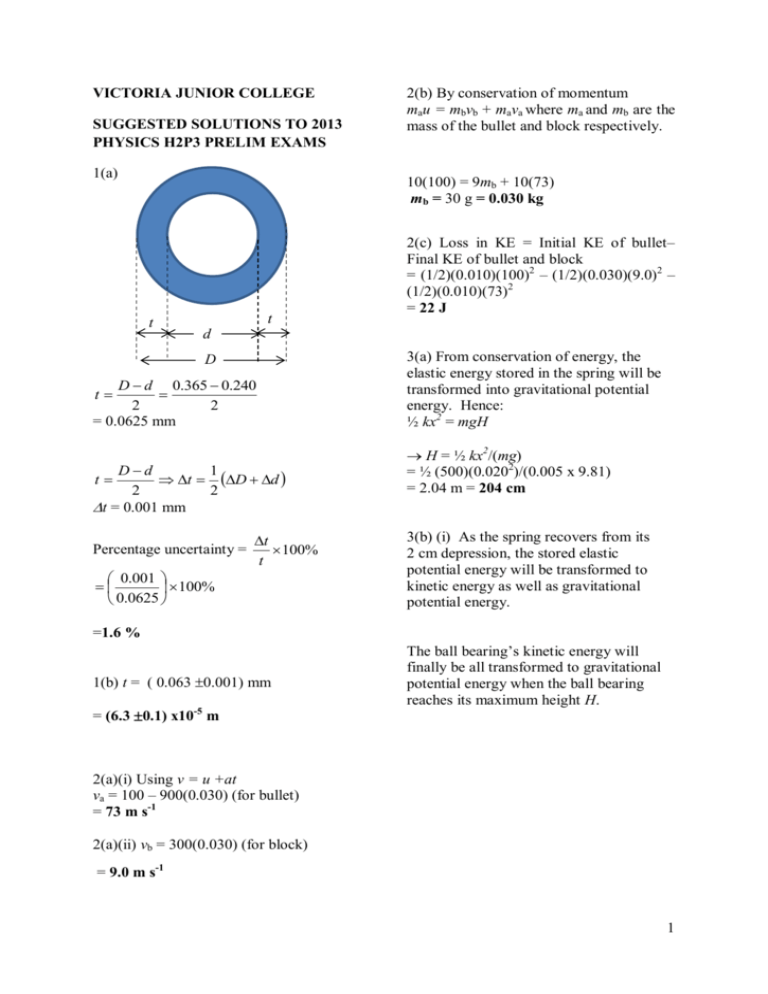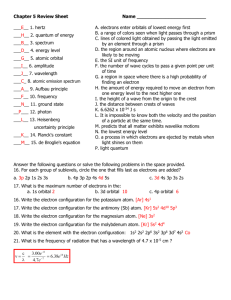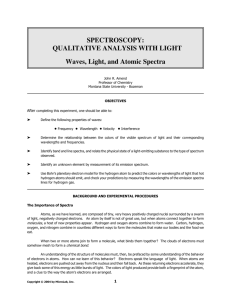2013 VJC PH H2 P3 Prelim soln
advertisement

VICTORIA JUNIOR COLLEGE SUGGESTED SOLUTIONS TO 2013 PHYSICS H2P3 PRELIM EXAMS 1(a) 2(b) By conservation of momentum mau = mbvb + mava where ma and mb are the mass of the bullet and block respectively. 10(100) = 9mb + 10(73) mb = 30 g = 0.030 kg t t 2(c) Loss in KE = Initial KE of bullet– Final KE of bullet and block = (1/2)(0.010)(100)2 – (1/2)(0.030)(9.0)2 – (1/2)(0.010)(73)2 = 22 J d D D d 0.365 0.240 2 2 = 0.0625 mm t Dd 1 t D d 2 2 t = 0.001 mm t Percentage uncertainty = t 100% t 0.001 100% 0.0625 3(a) From conservation of energy, the elastic energy stored in the spring will be transformed into gravitational potential energy. Hence: ½ kx2 = mgH H = ½ kx2/(mg) = ½ (500)(0.0202)/(0.005 x 9.81) = 2.04 m = 204 cm 3(b) (i) As the spring recovers from its 2 cm depression, the stored elastic potential energy will be transformed to kinetic energy as well as gravitational potential energy. =1.6 % 1(b) t = ( 0.063 0.001) mm = (6.3 0.1) x10-5 m The ball bearing’s kinetic energy will finally be all transformed to gravitational potential energy when the ball bearing reaches its maximum height H. 2(a)(i) Using v = u +at va = 100 – 900(0.030) (for bullet) = 73 m s-1 2(a)(ii) vb = 300(0.030) (for block) = 9.0 m s-1 1 Energy /J 0.10 about the centre of mass is unbalanced, and will cause him to topple. epe gpe 5(a)(i) ke p/ Pa A height risen /m p1 B p2 C 0.020 2.04 V1 V2 V/ cm3 Lowest point 4.(a) R can be resolved into its vertical and horizontal components Ry and Rx respectively. Ry = W = mg for vertical equilibrium. 5(a)(ii) The First Law of Thermodynamics states that the increase in internal energy of the system is equal to the sum of the heat supplied to the system and the work done on it i.e. U Q W . For an isothermal expansion, ΔU = 0 since the temperature is kept constant. Rx provides the centripetal force and is equal to mr(2/T)2 tan = Rx/Ry = mr(2/T)2/mg = (83)(2/20.0)2/9.81 = 39.9 0 4(b) f wall W For an adiabatic expansion, ΔQ = 0 and ΔW is negative. Hence, there is a decrease in internal energy of the gas. As the internal energy of the gas decreases, temperature also decreases. Using pV = nRT, at the same volume, since Tc < TB, PC < PB. N f is the frictional force, N is the normal force of wall on motorcycle, W is the weight of the motorcycle and man. Q6(a) R L A 1.25 10-7 0.80 4.0 Ω 2.5 108 If the motorcyclist is oriented perpendicular to the wall surface, the anticlockwise moment due to friction 2 6(b)(i) P.D. across XY = I 4.0 5.0 V = 3.33 V 4.0 2.0 Balance length = 3.0 0.80 = 0.721 m 3.33 6(b)(ii)V = IR, or I P 4r 2 4.18 x1013 x 2.50x1.6x10 13 4 (1.50) 2 = 0.591 W m-2 3.0 = 1.5 A 2.0 Section B 6(b)(iii) P.D across the XP is now 1.5 x 1.0 Ω = 1.5 V New balance length = 1.5 80 36.0 3.33 8(a) The speed of the wave is given by v f T cm = 0.360 m Q7(a) The possible reactions include: 0.4 0.32 m s -1 1.25 8(b) The displacement time relation for 2π point A is y A 0.020sin( t) 1.25 Or y A 0.020sin(5.03t ) 60 Cu01n27 Co24He 63 29 60 Ni 12H 27 Co 24He 62 28 60 Co 01n 27 Co 59 27 Q7(b) The activity of the 1.00 g sample, A N ln 2 1 x x 6.02x10 23 s -1 (5.27 x365x 24x3600) 60 8(c) A and B are separated by distance = 2.25 . The phase difference is equivalent x to a separation of 0.25. x 2 0.25 x 2 π rad 1.57 rad 2 Power of radiation from source is P = AE = 4.18 x 1013 (1.17+1.33)(1.6x10-13) W 8(d) As the wave spreads out from a point source, the total energy of the wave will be distributed to and shared by the spreading ripples. Hence the intensity of radiation at 1.50 m is This results in a reduced amplitude in the wave away from the source. 4.18x1013 s -1 3 8(e)(i) The frequency of the oscillation of 1 0.10 the seed = 2 2.5x1 0 3 = 1.0 Hz 1 2 2 (3.95x10 3 )( ) (1.8x10 2 ) 2 2 1.25 1.62x105 J 9(a) 8(e)(ii) The frequency of the ripples is f =1/T = 1/1.25 = 0.80 Hz. The seed will be set into forced oscillation at the frequency of the ripples, which is 0.80 Hz. As the natural frequency of the seed is higher at 1.00 Hz, its amplitude of oscillation is small. 9(b) Induced e.m.f. in vertical side is E = B0lvsin This is because there is no resonance. 8(e)(iii)1. The mass of the seed will increase causing its natural oscillation frequency to decrease. At a certain critical mass when its natural frequency has dropped to close to the ripple frequency of 0.80 Hz, it will be driven into resonance with increased amplitude of oscillation. But as its mass continues to increase with more water taken in, its forced oscillatory amplitude will decrease due to its much smaller natural frequency. 8(e)(iii)2. When the seed is oscillating with maximum amplitude, its frequency of oscillation will be 0.80 Hz (resonance). Its soaked mass is now given by: 1 0.10 0.80 m 3.95x10 3 kg . 2 m The total energy of the seed’s oscillatory motion, 1 E m 2 A 2 2 ( ) 9(c) Vertically downwards. 9(d) Q will be at a higher potential than P. 9(e) When t = 0, = 0o When t = T / 4, = 90o This is the e.m.f. induced in each of the two vertical sides. Hence, the total e.m.f. induced in the structure would be equal to Hence, the induced e.m.f. at time t is given by: E 𝐵 𝑙 𝜔 4 0 T t with time. Consequently, the induced e.m.f. will also be reduced with time. Induced e.m.f., E t 0 9(k) The rotational mechanical energy of the ring is converted to electrical energy () v 9(g) I A and finally into heat energy which is dissipated to the surroundings. B 𝑙 F F 𝑙 I D v 9(h) Torque on ring ( ) = 10(a)(ii) n ( ) ( ) ( 10(a)(i) The square of the amplitude of the wave-function is a measure of the probability of locating a particle in a small region of space. As there is no probability of locating an electron beyond the infinitely high walls of the box, the amplitude of the wave-function must vanish at the walls. ) λ L ….(1) 2 10(a)(iii) The kinetic energy of the p2 electron is given by E 2m E h2 h …..(2) (since p ) 2 2m 2L . Substituting into (2), we n h2 n2 n2 h2 have E 2m( 4 L2 ) 8mL2 In (1), 9(i) The torque has the effect of retarding the rotational motion of the ring. 9(j) Due to the retarding torque, the rotational speed of the ring will slow down 5 10(a)(iv) The longest wavelength of a photon that can be absorbed corresponds to a transition from n = 1 to n =2 (smallest energy difference) h2 hc (2 2 12 ) 2 longest 8mL L 3hlongest 8mc 3(6.67 x10 34 )(1.0x10 7 ) 8(9.11x10 31 )(3.0x10 8 ) 3.0 x 10-10 m 10(b)(i) When an electron comes close to a positive nucleus, it will veer in its path and lose a certain amount of kinetic energy. This loss of KE manifests itself as a photon of X-ray that is emitted. Large numbers of bombarding electrons lose different amounts of KE in their interactions with nuclei. This leads to a large number of wavelengths being emitted, resulting in the continuous spectrum. 10(b)(ii) From the Duane-Hunt rule, the entire KE of the bombarding electron gets converted into the energy of an X-ray photon. p2 h2 hc K 2 2m 2m min 10(b)(iii) The first group of sharp peaks corresponds to the K-series lines. The energy differences for the formation of K lines are bigger than those for L-lines, resulting in shorter wavelengths for the former. 10(b)(iv) One possibility is the electron gets ejected from the atom, changing it into an ion. If the outer electron is excited but not ejected from the atom, it may de-excite but produce a photon of longer wavelength compared to the K or L series lines. 10(b)(v) The minimum X-ray wavelength originates from an incoming electron losing all its energy in its interaction with a target nucleus. The wavelength thus depends only its initial KE and therefore only the tube voltage and is independent of the nature of the target nucleus. Characteristic X-rays are formed from electron transitions within atoms. Different characteristic wavelengths are due to different energy levels within atoms. Hence characteristic wavelengths depend on the nature of the target atom. ******** END ******** where is the de Broglie wavelength. 2mc2 min h 2(9.11x10 31 )(3.0x10 8 )(8.0x10 12 ) 2 6.63x10 34 -11 5.27 x 10 m 6








